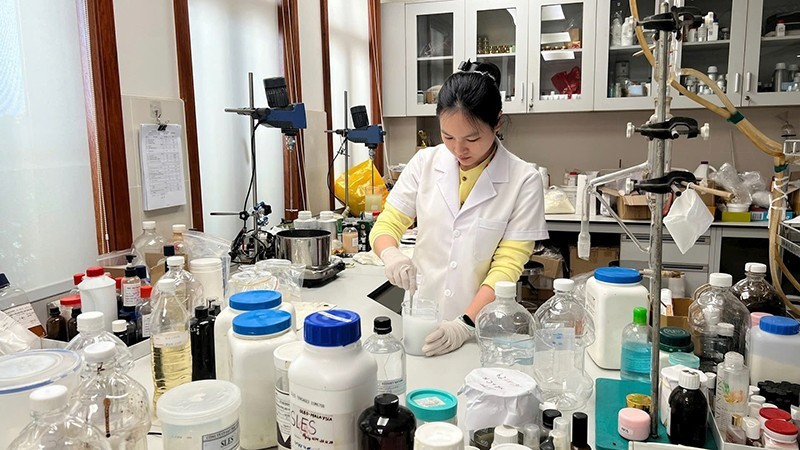Promoting deeper business engagement in innovation
As private enterprises increasingly affirm their role as a driving force behind the nation’s economic growth, the decision by some companies to invest in science and technology early has helped spread a spirit of innovation throughout the business community.

Pioneering innovation
More than two decades ago, when domestic cosmetic products were largely overshadowed by foreign imports, the Sao Thai Duong Joint Stock Company took a different path by developing herbal-based products using Vietnamese ingredients, grounded in scientific research and with a focus on public health benefits.
Despite receiving no state support or preferential treatment, the company remained committed to building a purely Vietnamese brand – from research to commercialisation.
That decision has since proven sound. The company’s innovations, including herbal health products and a treatment to support COVID-19 patients, have gained recognition domestically and internationally.
When the Traphaco Joint Stock Company transitioned from a state-run entity to a joint stock company, it essentially started again from scratch – lacking capital, advanced technology, and a professional research team. From a modest state-owned unit, the company had to navigate a fiercely competitive pharmaceutical market, flooded with imported products.
The biggest challenge was not just the lack of funding, but the shortage of qualified research personnel. Instead of focusing solely on distribution or outsourcing, Traphaco chose a more difficult route: investing in research and product development based on local medicinal herbs.
The company’s success in developing distinctive products from Vietnamese herbal medicine demonstrates the value of that direction. Traphaco not only mastered production technologies, but also laid the groundwork for a science-and-technology enterprise model in Viet Nam’s pharmaceutical sector.
Their willingness to invest in knowledge and technology helped the company gradually assert its market position and become a symbol of innovation closely tied to national identity.
However, the journeys of Sao Thai Duong and Traphaco have been arduous – particularly in accessing research policies and resources.
Barriers need to be removed
According to Nguyen Thi Huong Lien, Deputy General Director of Sao Thai Duong, the greatest challenge in scientific and technological investment is the lack of connectivity with policy frameworks, scientists, funding sources, technical support systems, and research facilities.
Although policies supporting enterprise science and technology have existed since 2013 with Decree 80/2013/ND-CP and, more recently, Decree 13/2023/ND-CP, access to these incentives remains limited. A survey by the Viet Nam Association of Science and Technology Enterprises found that 70–80% of eligible businesses chose not to apply for support due to complicated procedures or due to a fear of bureaucratic hurdles.
Policy interpretation and implementation also vary widely across localities. In some places, the same regulation is facilitated; in others, additional conditions are imposed, causing delays and discouraging businesses.
Another barrier lies in the disconnect between academia and industry. “Many scientists are highly capable but don’t know how to bring their research into real-world application or engage with businesses,” said Lien. Conversely, many businesses have urgent practical needs but don’t know whom to approach or where to look.
Moreover, registering for international patent protection – essential for accessing global markets – remains out of reach for most private companies due to the prohibitively high costs involved.
A notable policy highlight is the Politburo’s Resolution No. 68-NQ/TW on developing the private economy, which identifies private enterprises as not only growth drivers but also pioneers in scientific research, innovation, and digital transformation.
The resolution proposes systemic solutions to remove longstanding bottlenecks and seeks to establish a truly enabling innovation ecosystem.
The resolution calls for reducing at least 30% of legal compliance costs and 30% of business administrative conditions, promoting post-inspection processes, and limiting the “ask-give” mentality.
Policy priorities should focus on private-sector investment in science, technology, and innovation: expanding corporate income tax incentives, creating venture capital funds and preferential loans, and supporting small and medium-sized enterprises in developing new technologies and products. Businesses should also be encouraged to participate in the bidding for technology and national research tasks.
A transparent and efficient technology market must be built, allowing enterprises to easily access and transfer technologies and connect with scientists. A national database of experts, patents, and research should be developed.
The resolution also stresses the role of entrepreneurs, recognising them as frontline warriors in the economic arena who deserve training, respect and encouragement to nurture their aspirations and encourage further contributions.
Some business representatives said that it is necessary to complete and effectively implement policies to support science and technology enterprises; remove institutional and legal barriers and obstacles to promote cooperation between research institutes, universities and enterprises to share resources and experiences.
In parallel, a transparent technology market must be established to facilitate technology transfer. Mechanisms and platforms are needed to enable information and resource sharing among stakeholders, while investment in research infrastructure and equipment should be significantly increased.








